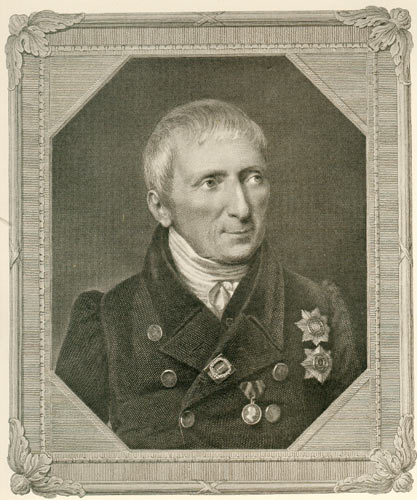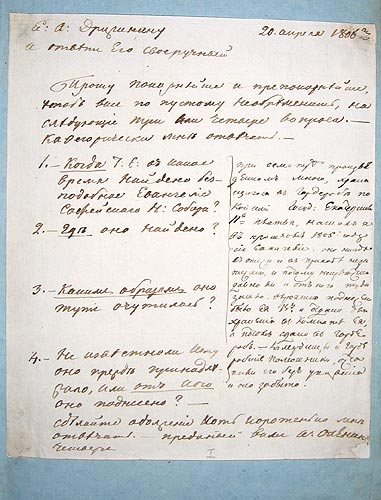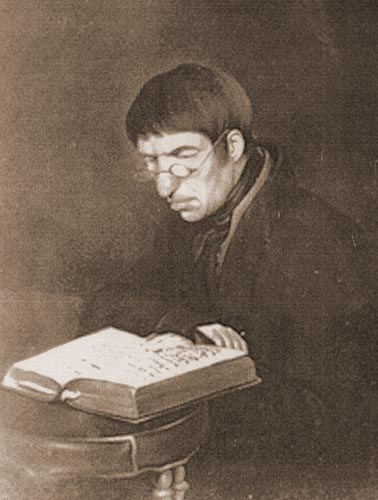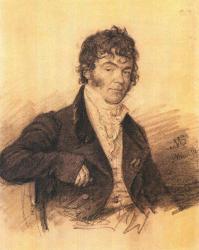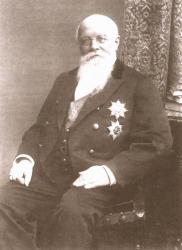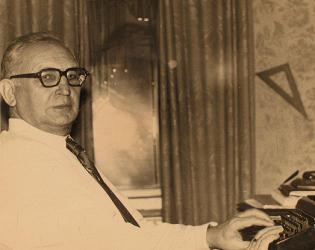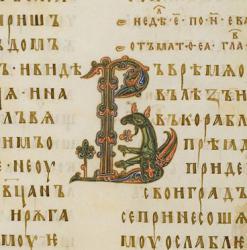Ostromir Gospels
Director of the Imperial Public Library A. Olenin and Curator of Manuscripts A. Yermolayev were the first to study the Ostromir Gospels. There is a surviving letter, dated 1806, from A. Olenin to Ya. Druzhinin, private secretary of Catherine II. Druzhinin was the person who found the manuscript in Empress's wardrobe after her death. The letter contains questions about the Ostromir Gospels and the answers of Druzhinin, added to the same sheet.
These answers do not clarify the "Petersburg" period of the book's history, except for the time and place of the manuscript's discovery in the chambers of Catherine. A. Druzhinin had no idea when and under what circumstances Catherine the Great had become an owner of the Ostromir Gospels.
The Manuscripts Department possesses a small archive of A. Yermolayev who was the first researcher of ancient manuscripts in Russia. Not only A. Olenin, but also the famous historian N. Karamzin learned paleography from him. His detailed descriptions of manuscripts laid the foundations for the scientific study of the Department's holdings. A. Yermolayev himself produce a handwritten copy of the entire text of the Ostromir Gospels. The copy is still housed in the Manuscripts Department (FS RNB F.I.55). It represents a paper volume with a white date "1805", in a typical cardboard binding covered with marble paper. The already mentioned Olenin's message with the answers of Druzhinin is pasted to the first sheet. The text of the Ostromir Gospels is reproduced by Yermolaev line by line, letter by letter, with all the superscripts and notes. All details of the decoration are also described. This handwritten copy is a true feat of the curator. It is important to emphasize that this was the first duplicate copy. It allowed researchers to study the manuscript without damage to the original.
The copy made by A. Yermolayev, was used in the first linguistic study of the Ostromir Gospels. And here we need to remember Piotr Frolov whose name undeservedly remained "in the shadow". The history of the national repository of manuscripts began with the outstanding collection of Piotr Dubrovsky. The second important collection, containing more than 200 manuscript books and scrolls, was obtained by the Library in 1817 from the prominent mining engineer and inventor Piotr Frolov. Frolov entered the history of engineering as the designer and builder of the first horse-drawn railroad and the first railway bridge in Russia. At the same time, Frolov was a well-known politician — a governer, then a senator and a member of the ministry's council. He established libraries and schools in the vast territories of the Altay region and founded the first local history museum in Siberia in 1827.
To prove the origin of the Ostromir Gospels from Novgorod, P. Frolov tried to find the features of the Novgorod dialect in the text of manuscript. He made a word-by-word comparison of the Ostromir Gospels with two ancient Gospels from his collection, written in Novgorod (OR RNB. F.п.I.7), (OR RNB. F.I.17). Differences were recorded on the pages of the Yermolaev copy as paginal notes. The collation was not carried to the end, because it became evident that the Ostrohmic Gospel lacks of Novgorod language features.
The unique landmark, received by the state depository, immediately became available for scientific research. At the first stage of the scientific study of the Ostromir Gospels, the results of this research were readily reported to all interested, including the famous historian N. Karamzin, the first publisher of the Epilogue of Deacon Gregory.
The next major contribution to its study was provided by Alexander Vostokov. Vostokov served as an assistant and then Curator of Manuscripts for 28 years and so had the richest material for research. In 1820, he created one of foundational texts of Slavic linguistics Discourse on the Slavic language. The publication shortly made Vostokov a scientist, known in all Slavic countries. Vostokov proved that the Ostromir Gospels is a landmark of the all-Russian literary language which derived from the common Slavic language.
In 1843, Vostokov prepared the first scientific edition of the Ostromir Gospels. The publication became possible with help of the Academy of Sciences. The text was published as true to the original source as possible. It was printed with special type, similar in form to handwritten letters. The annex shows lithographed drawings of all three miniatures of the Ostromir Gospels and facsimile images of two sheets (fol. 89 and fol. 210v). The Ostromir Gospels is accompanied by the corresponding Greek text from two editions of the New Testament, published in 1703 and in 1830. The scientific aids consists of detailed paleographic notes, a linguistic analysis of the text, and a large word index. Vostokov's edition has not lost its scientific significance so far, although it has long become a bibliographic rarity.
Thanks to the broad scientific ties of Vostokov, the Ostromir Gospels became the object of research by many scientists in the Slavic countries and throughout the world. It is enough to name the Czech linguists Josef Dobrovsky with his 1823 book Cyril and Methodius — Slavonic Apostles and Wenceslaus Hanka who published the first foreign edition of the Ostromir Gospels in 1853 in Prague. Among researchers are the Slovenian scholar Jernej Bartol Kopitar who, in 1830, discovered the famous Glagolitic Clozianus, similar in spelling to the Ostromir Gospel; the Slovak historian Pavel Šafárik, one of the founders of the comparative study of the language, literature and ethnography of the Slavic peoples.
The historian, future academician and Director of the Public Library, Afanasy Bychkov (1818-1899) was appointed the head of the Manuscripts Department after A. Vostokov. He published several articles dealing with the Ostromir Gospels. In one of them A. Bychkov drew attention to the symbols of ekphonetic notation, emphasizing that their set is not complete in the Ostromir Gospels. At that time, scientific research focused on linguist study of the Ostromir Gospels as a landmark of Russian writing and language. The book was explored by the prominent scholars: F. Buslaev, I. Sreznevsky, A. Potebnya, V. Shchepkin. The study of the manuscript was based on Academician A. Vostokov's work.
In 1856, A. Bychkov organized an exhibition of the Ostromir Gospels and other illuminated manuscripts to mark the 800th anniversary of the book. The exhibition promoted further research. At the anniversary exhibition, the Ostromir Gospels was first seen by the leading art critic Vladimir Stasov (1834–1906). This was the beginning of the study of the manuscript from the artistic point of view. Stasov noted that the initials of the Ostromir Gospels weren't exactly alike those in Russian or Byzantine manuscripts of the 9th-11th centuries. The Ostromir Gospels is constantly mentioned in V. Stasov's works on the history of ornament. Stasov came to the conclusion that the manuscript was decorated by group of Russian artists - miniaturists and ornamentalists (at least three miniaturists and two ornamentalists).
In 1881, A. Bychkov's son Ivan became Curator of the Manuscripts Department. Ivan Bychkov (1858–1944) was a famous archeographer, corresponding member of the Academy of Sciences, he also contributed to the study of the Ostromir Gospels.
In the late 19th century, the merchant Savinkov provided funding to publish the photolithographed editions of the Ostromir Gospels. This publication made the manuscript widely known in Russia. In many education institutions, it was used to teach the Old Slavonic language.
The Savinkov publication inspired new studies of the book, which led to important conclusions. Thus, M. Kozlovsky was first to notice that the manuscript was written by more then one scribe. F. Fortunatov found the language differences in parts of the book. He suggested that two manuscripts served as prototypes for the Ostromir Gospels. N. Karinsky proved that these differences resulted from the fact that the book was copied by two scribes (the third scribe painted the headings of readings in gold).
The 900th anniversary of Ostromir Gospels aroused an extremely high interest to the landmark in the mid-20th century. For the first time, the Ostromir Gospels was carefully restored by Elena Trey. Especially significant was the effect from the exhibition, organized in 1957 in the Manuscripts Department by Custodian of the Old Russian collection Nikolay Rozov. The scientist and book expert N. Rozov thoroughly described the history of studying and publishing the Ostromir Gospels. He issued archival documents that shed light on many curious details. On the exhibition, specialists were given the opportunity to get acquainted with the priceless original. Taking this opportunity, L. Zhukovskaya showed that it is impossible to determine where the Ostromir Gospels was created on the basis of linguistic data only. The exhibition also drew attention to the artistic decoration of the manuscript. Thus, A. Svirin saw the resemblance of its illustrations with miniatures of the Mstislav Gospel created in 1103-1117 by the scribe Alexa for Prince Mstislav of Novgorod. Due to similarity of ornamental motifs, A. Svirin suggested that Deacon Gregory and, after 60 years, the scribe Alex could use the same prototype.
In 1957, experts put a task to publish a facsimile of the Ostromir Gospels. Such a publication was produced with the active participation of N. Rozov and the support of the Moscow Patriarchate. The facsimile copy of the manuscript was eventually published in 1988 to mark the millenary of the Baptism of Russia. It is now used as the main duplicate of the priceless book.
The facsimile edition of the Ostromir Gospels contains articles on a large number of cultural and historical issues. It includes the research of Metropolitan Pitirim (Nechaev) on the composition of liturgical readings in the Ostromir Gospels. The broad social and cultural picture of Kievan Rus' was given by N. Lisov who assumed the Kiev origin of the Ostromir Gospels. A. Svirin continued his observations on the decoration of the book. N. Rozov found the echoes of the ancient Slavic pagan myths in the unusual initials of the Ostromir Gospels. A. Svirin saw in one of the initials (on fol. 66 v.) an image of the ancient Persian deity Simurgh depicted as a winged dog. The equivalent of Simurgh in Slavic mythology was Simargl. Perhaps, the oldest Russian book reflects a mixture of the two faiths – paganism and Christianity.
The facsimile was a substitute for the original to ensure it physical safety. It also facilitated a more detailed examination of its design. V. Lazarev stated that the Ostromir Gospels has some features of Western European art. He noted that pictures of evangelists with their symbols are not found in Byzantine manuscripts but is very common in Carolingian and Ottonian manuscripts. O. Popova developed the concept. She decided that the Ostromir Gospels was a sample of the Byzantine art that organically included elements of Western Ottonian art. Such a unique combination of traditions could appear only in the "autonomous" territory, free from these traditions, — in Russia. Popova emphasizes that the writing and decoration of the book were created at the one time and in one place, since they are served to the common aim. Popova identifies two masters who, perhaps, painted "faces" in the initials. At least one of these masters was a Byzantine artist, but he worked in Russia.
The known Slavist V. Zagrebin opens a special stage in the study of the Ostromir Gospels. Zagrebin was the curator of the Old Russian manuscripts for 30 years. His fundamental work Diacritics of Medieval Slavonic Manuscripts, are based on dozens of South Slavic and Old Russian manuscripts. It includes a chapter about the signs of ekphonetic notation in the Ostromir Gospels and in the Kupriyanovs (Novgorod) Leaves — a surviving fragment of the 10th - 11th century Gospel lectionary. Zagrebin proved that musical symbols in the early Russian manuscript had derived from the Greek signs.
The question how the Ostromir Gospels and Kupriyanov Leaves are linked to one another remains open. F. Fortunatov, based on linguistic data, concluded that both books were copied from the same orifginal. The well-known Yugoslav paleographer and historian V. Moshin suggested that the Kupriyanov Leaves are a fragment of the original manuscript from which the Ostromir Gospels was copied. The Head of the Manuscript Department A. Alekseev found convincing arguments for the proposal. A research project, conducted under his direction at the Russian Bible Society, showed the Novgorod origin of the Ostromir Gospels. In fact, fragments of the original of the Ostromir Gospels survive. They were discovered by I. Kupriyanov in Novgorod in the 19th century!
An essential milestone in the recognition of the Ostromir Gospels as a manuscript landmark of the national importance was 2007, when the general public celebrated 950 years from its creation. In St. Petersburg, Veliky Novgorod, and other cities of Russia, scientific, cultural and educational events, related to the first Russian dated book, took place. The events were vividly reflected in the media. Interesting historical and cultural publications appeared. The National Library of Russia held a scientific conference, the materials of which were issued in the collection of articles Ostromir Gospels and Modern Studies of the Manuscript Tradition of New Testament Texts (St.Petersburg, 2010). To commemorate the 950th anniversary of the oldest Russian book, the National Library of Russia presented the online exhibition The Ostromir Gospels and the Manuscript Tradition of the New Testament Texts. This resource allows us to show the Ostromir Gospels in the context of the previous Byzantine and subsequent Slavonic manuscripts.
The virtual version of the Ostromir Gospels is intended to open universal access to the unique handwritten book.
Since 2007, the Ostromir Gospels is a symbol of the annual Easter Festival in St. Petersburg.
